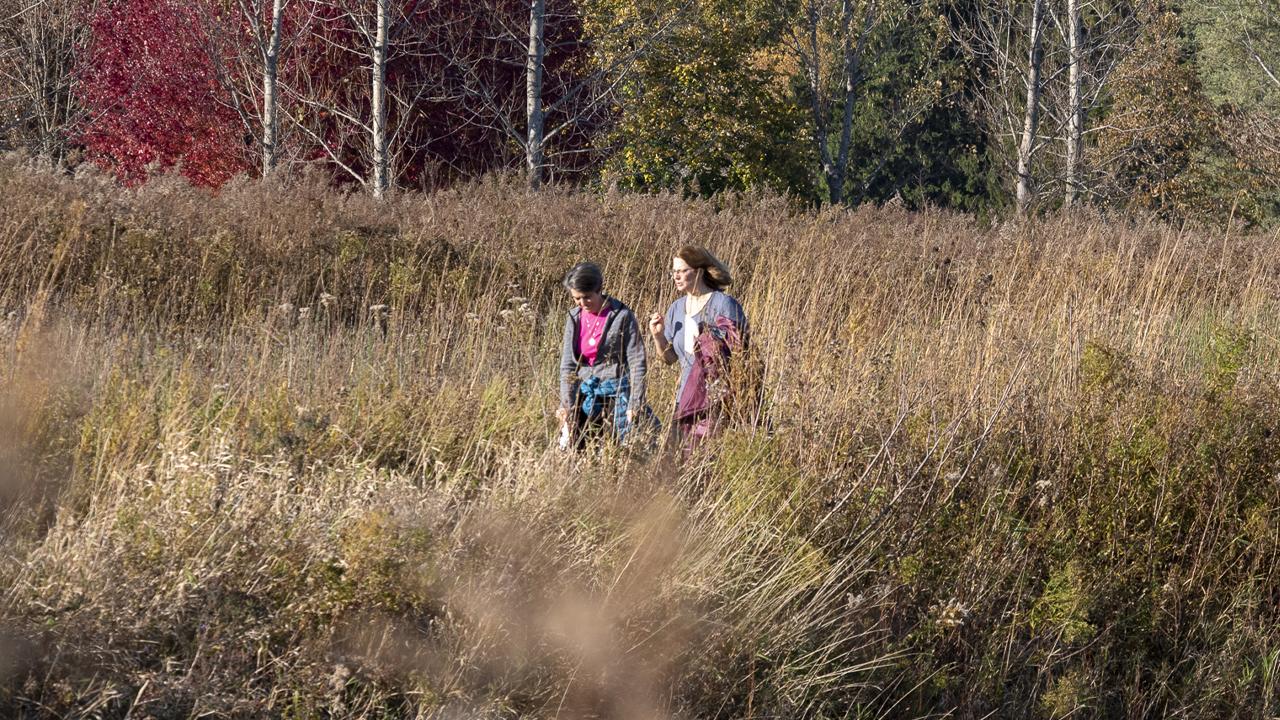

An Autumn Walk in the Dixon Prairie
A Very Different Garden Walk
What is it about walking in the Prairie that is so very different from any of our other Garden walks? Perhaps it’s the experience of seeing hundreds of diverse species of native plants growing so closely together, many of them taller than ourselves and completely unknown in our own gardens. Is it the knowledge that this semi-wild place is only a remnant of what once covered northeastern Illinois and much of the Midwest? Or, maybe what compels us to walk the Prairie in fall, when it’s at its prime, is a desire to pay respect to the land and reconnect with our own heritage. For whatever reason one walks in the Prairie this season, it will delight all—children, gardeners, bird-watchers, and nature enthusiasts—with its rich communities of life.
From the largest great blue or migrating white herons to the tiniest spiders spinning webs among the gauzy grass seedheads, the prairie is a source of food and refuge.
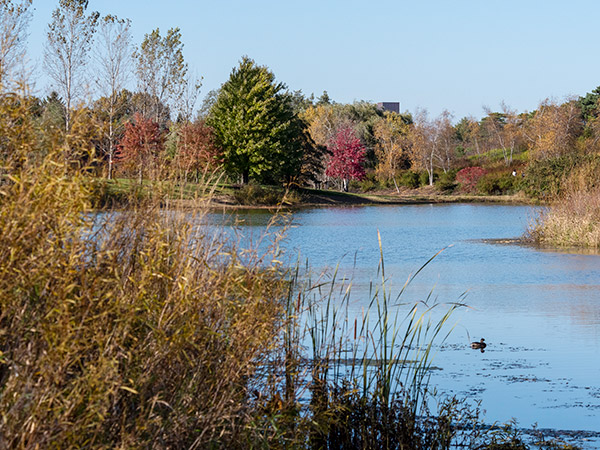
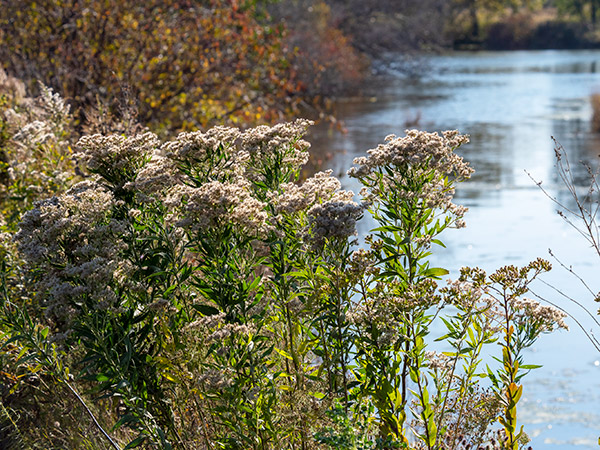
Hundreds of Plant Species Plus Birds, Mammals, Insects, and More
The Dixon Prairie is a 15-acre re-creation of six distinct prairie ecosystems that once existed in our area. What becomes quite obvious to visitors walking through these different prairie types in autumn is that plants share space with a wide variety of other life forms, which buzz, tweet, honk, hum, or sing as they go about their very busy business of gathering pollen, seeds, or nesting material. At no other season is this crescendo of activity more apparent than in autumn. With more than 250 diverse plant species spread over these rolling plains—all surrounded by water—the bird, mammal, reptile, amphibian, and insect life find a plentiful source for their needs. From the largest great blue or migrating white herons to the tiniest spiders spinning webs among the gauzy grass seedheads, the prairie is a source of food and refuge.
Why Burn?
The bur oak savanna prairie is easily identified by the presence of a few trees amidst the surrounding grasslands. Native bur oaks could withstand fire, which was a common occurrence in original prairies, and the occasional shade they provided encouraged a community of shade-loving prairie plants. Today, Garden scientists who monitor the Dixon Prairie continue this restorative practice of burning selected areas in early spring and late fall, when plants are not in active growth. The prairie benefits when invasive plants are burned out, as well as the dead and decaying dried plants that prevent new seedlings from emerging. Nutrients are released in this process and returned to the soil. Even with burning, the ecologists must be vigilant as they monitor the prairie’s health, which depends, like all ecosystems, on pure water, unpolluted soil, and a thriving interaction among the native communities.
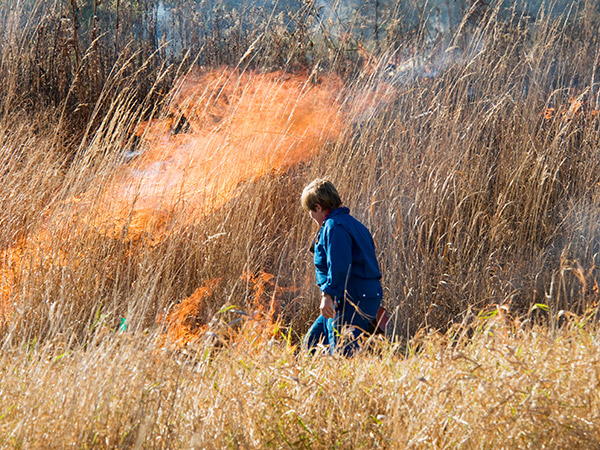
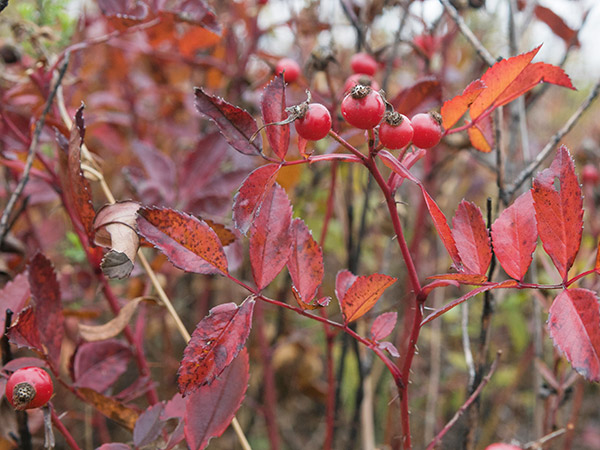
Sand Prairie, Gravel Hill Prairie
The sand prairie is typical of the landform that existed close to Lake Michigan’s southwestern shore, where a combination of sandy dunes and marshlands produced unusual plants, and became a beacon for migrating shore- and songbirds. Sandy soils drain quickly, while marshy areas retain water. The availability of water in the soil surpasses all other environmental factors in determining which plants grow where in a prairie. This is surprising to many visitors who think of the prairie as a dry, sunny, flat, open grassland. A quick stroll to the mounded hilly section of the Dixon Prairie, known as the gravel hill prairie, will prove otherwise. This prairie type was created by glacial dumping of crushed rocks, gravel, and sand. Because the incline is steep, moisture drains quickly, and only plants that can adapt to these unusual conditions will survive. Note how much shorter these prairie plants are, especially when compared with those in the tallgrass or mesic areas.
Fen Prairie, Wet Prairie
Both the fen and wet prairies feature rather inhospitable soil that holds water most of the year. The wet prairie is naturally located close to water; and the cold, wet soils of a fen are created when underground limestone deposits leach out and produce groundwater with a high mineral content. Both environments have grasses and perennials, which, in time, have adapted to these unusual conditions.
Tallgrass Prairie
There’s no denying that for many visitors, the rich tallgrass or mesic prairie recalls images of the great westward expansion of our country—images often created in literature, film, and television. That was a time when native forbs and grasses were known by their useful properties: rattlesnake master, compass plant, rosinweed, fleabane, switch grass, and tall boneset. Take a child through the tallgrass prairie and be prepared for the nonstop questions of “What’s that?” or “What does that name mean?” It’s a lesson in history. Still today, the tasseled fingers of big bluestem (or turkey foot) grass, and the bright yellow composite flowers of any of the dozens of sunflower-type plants, seem to dominate the textures and tapestry of this prairie. What a thrill to walk through this space, with plants on either side, towering above, all in different stages of development, even in autumn. Some asters are still tightly budded, while some coneflowers have already blackened and dispersed their seeds (aided by the fluttering finches). Grasses with puffy plumes are in full sway, and fall color has touched the leaves of many native flowering plants, creating a warm glow of ochre and olive. Still others remain bright, with their purple, pink, and white blossoms held high.
View from Afar and Up Close
When viewed from afar, the Dixon Prairie is a great study in movement, texture, and tones of this end-of-season time. But when you walk through it, you see each one of the thousands of plants come alive, some in flower, some with giant seedheads, pods, cones, or umbels, each in a different stage of life, each growing where it is for a reason. It is a breathtaking, humbling experience.

